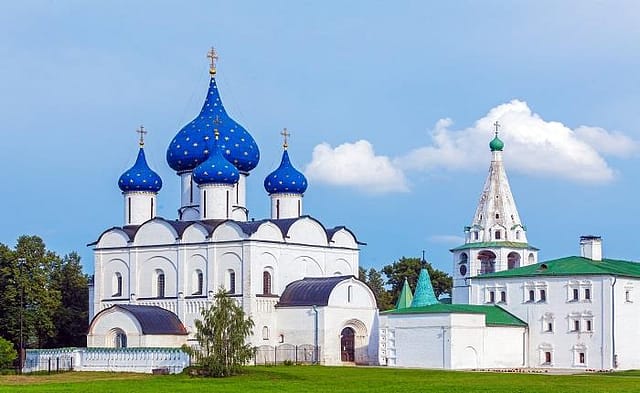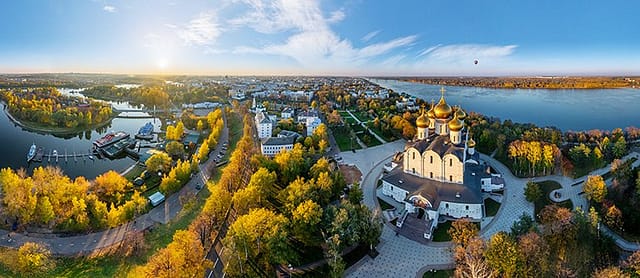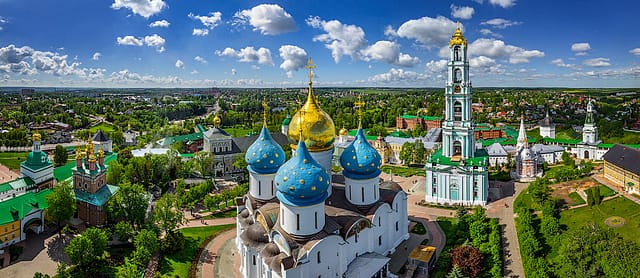In the cities of the Golden Ring of Russia miraculously preserved a rich living history and the Russian spirit. Here you can see the majestic cathedrals of the 12th-13th centuries, tent temples and get acquainted with traditional folk crafts.
Vladimir – the ancient capital of North-Eastern Russia and one of the most visited cities of the Golden Ring of Russia: several amazing monuments of Russian medieval white-stone architecture have been preserved here.
First of all, this concerns three attractions included in the UNESCO list of World Heritage Sites:
- Golden Gate (architecture) – a symbol of the greatness and power of Ancient Russia. They formalized the main entrance to the richest princely-boyar part of the city.
- Dmitrievsky Cathedral – a monument of the Vladimir-Suzdal architecture of the pre-Mongol period
- Assumption Cathedral- a masterpiece of white stone architecture. It is a unique treasury of Russian church art. The paintings of the 12th-19th centuries are preserved in it. The famous frescoes of the icon painter Andrei Rublev.

Suzdal – a museum town, about 200 historical monuments, many of which have the status of a UNESCO World Heritage Site. The city is called the “glorious city of heaven” and the “cradle of the Golden Ring.”
- The Suzdal Kremlin is the oldest building in the city, which has absorbed its entire history starting from Vladimir Monomakh. According to archaeologists, the Kremlin was built in Suzdal already in the 10th century, despite this, all its main buildings have survived to this day, with the exception of perhaps the protective walls and towers.
- Spaso-Efimiev Monastery with a bell ringing concert. In the monastery is the tomb of Prince Dmitry Mikhailovich Pozharsky – an outstanding Russian commander.
- Museum of Wooden Architecture with unique buildings from the 17-19th centuries. The museum is built in the form of a rural street with temples, residential buildings, mills, barns and other buildings transported from different villages and villages of the Vladimir region.
- Pokrovsky Monastery is a women’s monastery, which contains many secrets. After all, earlier it was not an ordinary monastery, but a place of lifelong exile for women from high society.

Yaroslavl is one of the brightest cities of the Golden Ring. The city center is located at the confluence of the Volga and the small river Kotorosl, where the Rostov prince Yaroslav the Wise in 1010 erected the walls of a new fortress – not far from the Viking trading outpost. The city celebrated its millennium in 2010 and became a UNESCO World Heritage Site.
- Transfiguration Monastery is the main city attraction. Thanks to the fortified walls, it is called the Kremlin. The main cathedral of the monastery has preserved the original paintings, it is the oldest of the temples of Yaroslavl that have survived to our time. Here was found a handwritten list of a masterpiece of ancient Russian literature, “The Word of Igor’s Campaign.”
- Governor’s House – a magnificent mansion built in 1823 for especially important receptions and residence of the Yaroslavl governors, in which all the emperors of Russia, from Alexander I to Nicholas II.
- Church of Elijah the Prophet – an outstanding monument of architecture of the Yaroslavl school of architecture.
- Another masterpiece of Yaroslavl architecture is the fifteen – domed Church of St. John the Baptist in the Tolchkovo settlement , consecrated in 1681 (external examination). It is this temple that is depicted on the banknote of the Russian Federation with a face value of one thousand rubles.

Kostroma is the same age as Moscow, the oldest jewelry center and the largest port city on the Volga. Acquaintance with the merchant city, which has preserved the original appearance of the architectural ensemble of the 18th century.
- Ipatiev Monastery (Trinity Cathedral, tomb or chambers of the Romanov boyars) – the main symbols of Kostroma, the cradle of the Romanov dynasty, because it was precisely in the Ipatiev Monastery of Kostroma that Mikhail Fedorovich Romanov was hiding from Godunov’s disgrace. Among the treasures of the Ipatiev Monastery are the unique Psalms, Gospels and Servants in precious robes and salaries.
- Epiphany-Anastasia Monastery, where the miraculous icon of the Mother of God of Fedorov (13th century) is stored, which was painted around 1239 and glorified by great miracles and healings. This is the oldest work of icon painting in Kostroma has long been revered as the protector of the city and the guardian of the Romanov family.
- It is also a must to see the Fire Tower of the 19th century – an outstanding monument of classicism, the guardhouse building, and get acquainted with the beautifully preserved ensemble of the Trade Rows, which have been functioning properly until now.

Rostov the Great – one of the oldest Russian cities, the birthplace of Russian saints, epic heroes and heroes. The city on Lake Nero is mentioned in the “Tale of Bygone Years” under 862 in connection with the vocation of Rurik. And as far back as the 12th century, Prince Yuri Dolgoruky called Rostov the Great. The Rostov prince was the holy prince martyr Boris, who died with his brother Gleb at the hands of the killers. On the Rostov land, the epic hero Alesha Popovich and Abbot of the Russian Land were born, the Monk Sergius of Radonezh. And two Rostov princesses – Daria Rostovskaya and Antonina Puzhbolskaya – fought together with their grooms and died in the Battle of Kulikovo.
- Metropolitan Courtyard, known as the Rostov Kremlin – the residence of influential Rostov metropolitans (XVII century). The architectural ensemble of the Rostov Kremlin has come down to us in all its splendor. Its decoration is the Assumption Cathedral (XVI century) with a unique belfry, which completely preserved a set of 15 bells, including the famous “Sysoy” – a giant bell weighing 2,000 pounds.
- The Spaso-Yakovlevsky Monastery ( XIV century) was elevated when in the XVIII century Metropolitan of Rostov became St. Demetrius – enlightener, playwright, the only Russian saint of the XVIII century. Dimitry of Rostov was the author of Chetii-Minei (Lives of the Saints), the most beloved worldly collection in Russia .The miraculous relics of Dimitry of Rostov are in the Conception Church (1689) of the monastery. The monastery, standing on the shores of Lake Nero, preserves the architectural development of the XVII-XIX centuries. And from the monastery tower offers a magnificent view of the huge lake and the ancient city of Rostov.
- Enamel Museum – “A miracle created by hands”. Finift – a type of enamel – the oldest craft of Russia, the most interesting type of miniature painting, which belongs to the elite art. This is always manual work, and the most complicated manufacturing technique and high labor intensity make each product exclusive.

The youngest city of the Golden Ring is Ivanovo. It was formed in 1871 by the merger of the old flax processing center in the village of Ivanovo with the industrial Ascension Posad and is located in the interfluve of two large Russian rivers – Klyazma and Volga. The city was known for the production of textiles since the XVII century. Linen and printed fabrics were in demand even abroad. Since then, the city has been called the chintz region, and also the textile capital of Russia and, of course, the city of brides
- Shchudrovskaya tentis the oldest of the surviving brick buildings in Ivanovo. Monument of architecture of federal significance. One of the symbols of the city. It is considered a unique example of civil stone architecture of the 17th century, which has no analogues in neighboring areas.
- Trinity Church of Ivanovo (other names: Trinity Church, Church of the Holy Trinity) – a new religious building. Outwardly, the temple looks modest enough, like old Russian churches. But inside it is crowned with a four-tier gilded iconostasis and is decorated with icons with gilded salaries. The temple has a unique backlight – out of five dozen light sources that are equipped with special automatic on and off modes. In the evening, the Trinity Church becomes a real decoration of the city ensemble of Ivanovo.
- The house-ship, designed by Moscow architect D.F. Fridman in 1930. It is a monument to the constructivism of the Soviet era in Ivanovo. It really looks like an amazing ship floating on city streets. The glazed ground floor only enhances this unusual effect. It is hard to believe, but this is an ordinary residential building, it has 212 apartments.
Pereslavl-Zalessky – was founded in 1152 by Prince Yuri Dolgoruky. Pereslavl is famous not only for its beautiful views and architectural masterpieces, many of which are almost 10 centuries old. For such a small town, it has an amazingly rich history. Prince Alexander Nevsky was born here, Pereslavl was loved and often visited by monarchs, and Peter I made the city the cradle of the Russian navy.
- Assumption Goritsky monastery. In 1382, Pereslavl, and with it the monastery was ruined by Khan Tokhtamysh. Soon the monastery was restored by the wife of Grand Duke Dmitry Donskoy – Evdokia. The Cathedral of the Assumption of the Blessed Virgin Mary, which gives the impression of a magnificent palace, was built in the 1750s. The most amazing treasure of the cathedral is the iconostasis, which stands out even against the backdrop of all the luxurious decoration. The Church of the Epiphany of the Lord is clearly visible from afar thanks to the massive bell tower, which was restored in 1996. A beautiful view of the whole Pereslavl-Zalessky opens from the observation deck of the upper tier. The entrance gate is decorated with the Church of St. Nicholas the Wonderworker, built in the second half of the 17th century.
- Museum-estate “Boat of Peter I”This is the first provincial museum in Russia. On its pediment gold is carved: “The Great Peter the zealous Pereslavl.” In 1802, Vladimir Governor Ivan Dolgorukov visited a place where, according to him, “a strong Peter studied sailing and left the city the first boat he built in our country as a guarantee for himself”. Fulfilling the decree of Peter, he decides to build a building for storing the bot.
- Berendey House. Grandiose chambers were built for the character of Berendey – a real wooden tower, descended from the pages of fairy tales. In Pereslavl-Zalessky it was decided that this mysterious character lives with them, taking an example from the Kostroma Snegurochka and the Great-Santa Claus. The house is painted with Russian patterns of bright colors. Children are waiting for toy workshops here. And, of course, Berendey himself will entertain the visitors.

Sergiev Posad grew up more than 700 years ago around the Trinity Monastery, founded by Sergius of Radonezh, and for a long time played an important role in the development of Russia. Around the monastery, peasants began to settle, forming settlements, settlements of artisans. In 1408, the monastery was completely burned by the Tatar khan Edigey, later the successor of Sergius, the abbot of the monastery Nikon of Radonezh, will undertake to restore it. In 1540, the construction of defensive structures — brick walls with towers — began in the monastery. But Ivan the Terrible himself, who was baptized in the Trinity Cathedral, helped transform the monastery into a powerful fortress. The ensemble of the monastery gradually increased to 50 buildings – temples, churches, chapels, royal chambers, treasury chambers, bell towers, refectory. Trinity Lavra of St. Sergius is a UNESCO World Heritage Site (since 1993).
- Trinity-Sergius Lavra . The Trinity Lavra of St. Sergius is the pearl of the Orthodox shrines of Russia with a long history. The architectural ensemble of the Trinity-Sergius Lavra is under the protection of UNESCO.
- Trinity Cathedral – the main cathedral church and the oldest surviving structures of the Trinity Monastery, the first stone building of the Lavra. The main relic of the cathedral are the relics of St. Sergius of Radonezh.
- Assumption Cathedral is the architectural center of the Trinity-Sergius Lavra. He is inferior in seniority to the famous Trinity Cathedral, but nevertheless, by his location and strict majesty, he leads the Lavra group of buildings.









